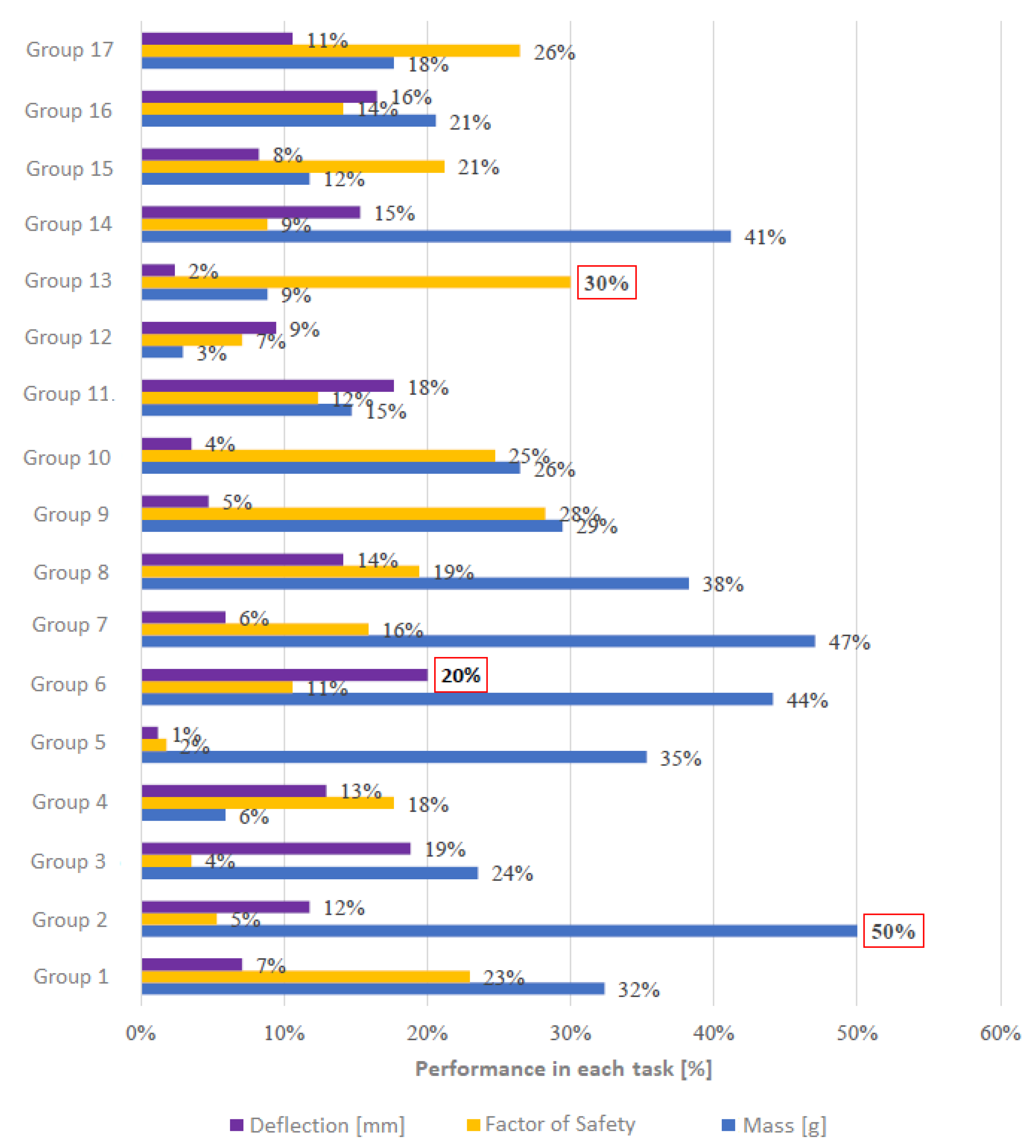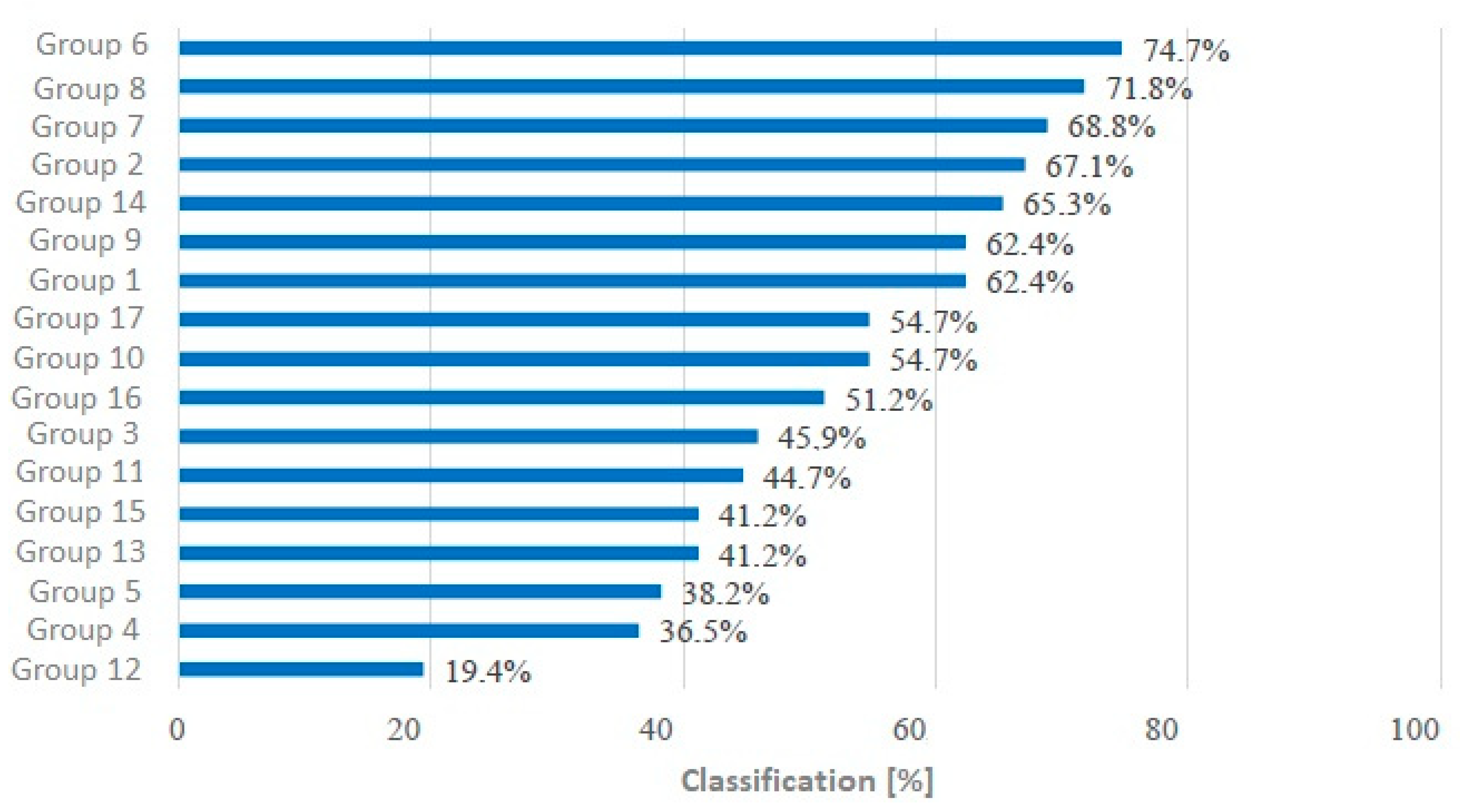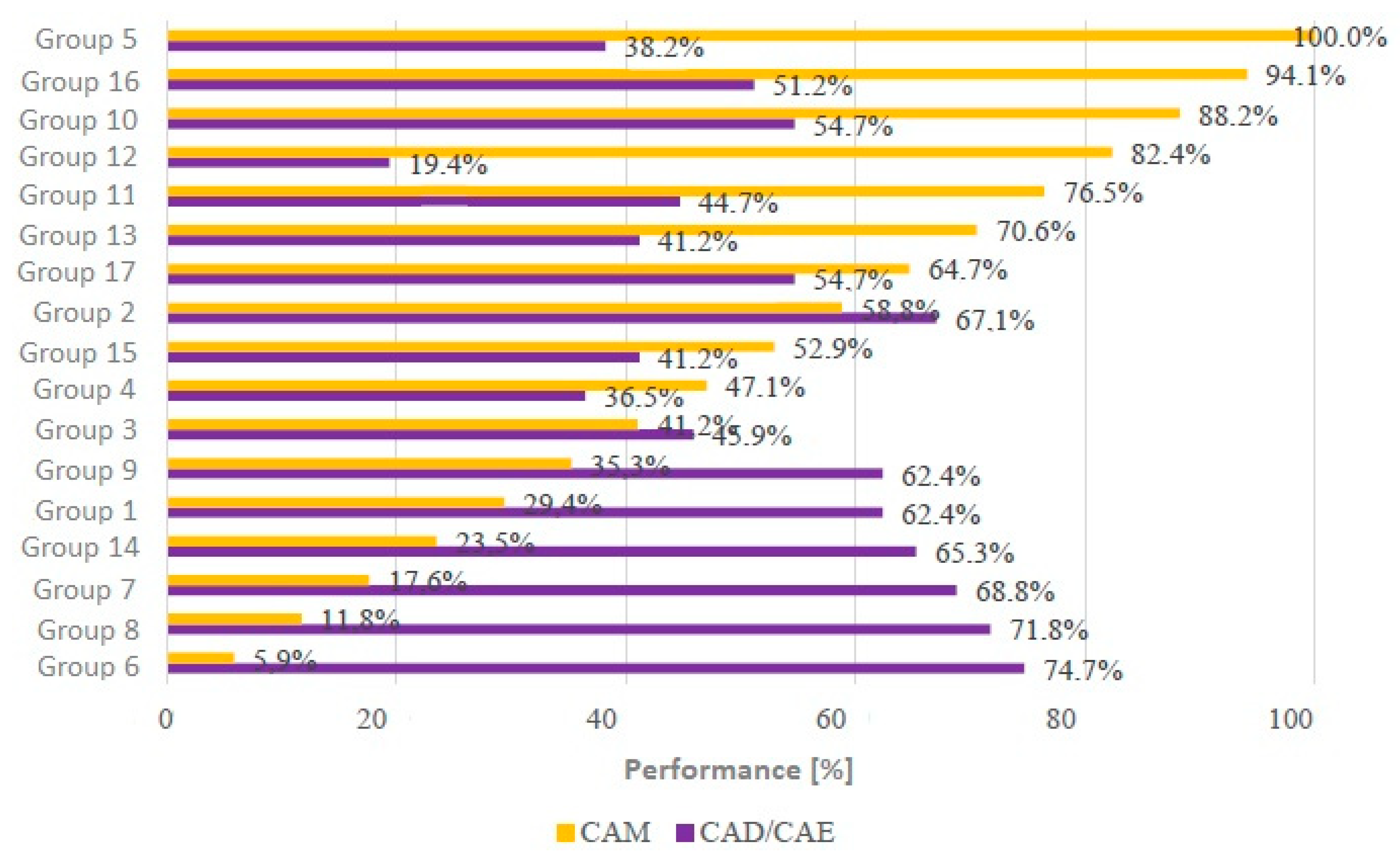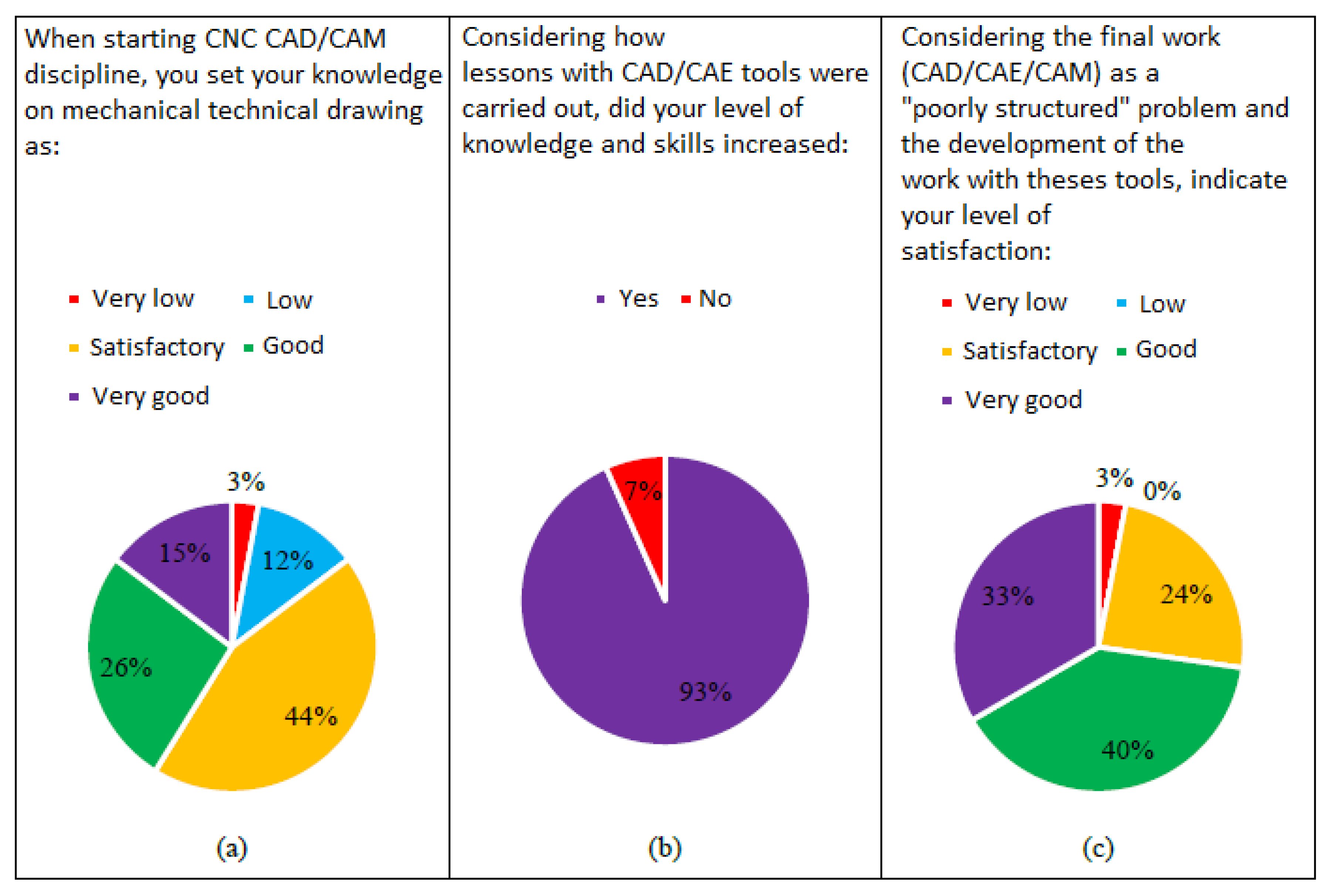1. Introduction
Education is one of the main transforming agents of society, promoting scientific and technological advances and boosting businesses and economies all over the world [
1]. Higher education is seen as a mechanism of satisfying societal demands, being fundamental for the technological and economic development of any nation [
2]. Additionally, engineering has a leading role in the transformation of societies, as a large part of technological developments are born in this area [
3].
In this context, the role of universities is to provide the best training for future engineers, forming a modern and flexible graduate profile, consistent with the current demands of the professional market. Maraghy [
4] comments that society is a complex system of interactions, and because of that higher education courses need to prepare their students for this scenario, especially engineering courses.
At the same time, companies work in a highly competitive environment, forcing them to develop strategies that provide long-term business sustainability, meeting the needs and desires of their customers, such as quality products, reduced costs and even shorter delivery times [
5]. This competitiveness, in the capitalist world, has to be assimilated by students during their years in academia, so that they can be prepared to face such reality right after finishing studies.
In this environment, where technology rapidly transforms society, engineering professors and students are faced with the challenge of following these developments properly, which requires the increase of transversal and self-learning skills. This growing technological development impels future engineers to develop a global perspective, not only local, with Higher Education Institutions (HEIs) taking on this transforming role [
6].
Traditionally, the teaching methodology is based on a model in which the instructor exposes knowledge in a classroom and the student tries to assimilate it in the best way possible (passive method). However, over the last decades, with the advances in learning theories, the methodologies have stopped focusing on teaching to focus on learning, giving rise to Active Learning Methodologies (ALM), where, through skills development, students acquire the ability to solve problems in a structured and autonomous way [
7,
8].
In this context of adequately preparing the graduate profile for the current flexible and continuously changing job market, universities have embraced and adopted, through the use of active learning methodologies in classes, this novel paradigm of HEI’s role in the training of future mechanical engineers. The authors believe that this new learning methodology proposal helps the teacher to positively transform the student, providing more dynamic forms of learning, making it more sustainable, giving more meaning to the information discussed in class, and finally making the presented/discussed content not only understood but actually learned and applied [
7]. Team-based co-curricular activities linked to problem-based learning can offer students a quasi-authentic experience of engineering practice, stimulating students to assimilate their prior knowledge and skills whilst enhancing professional attributes [
9].
SATC (Criciuma, Brazil) is an HEI focused on engineering and technology. Over the last few years, they implemented the referred ALM throughout the institution graduation programmes, consistently supported by the literature. They emphasized the promotion of a methodology continuously addressing realistic problems in classrooms, with industrial support, seeking creative and critical professional suppliers who know how to collaborate in work teams [
10], applying technology to education and consequently adding quality in the whole teaching–learning process, in the best interest of the students. However, given the diverse and distinct possibilities of ways to work with this new learning methodology proposal, PBL (Problem-Based Learning) was chosen by SATC, as it provides knowledge development resources, attitudes and skills that are so important for professional training in an integrated framework, approximating academia to professional practices [
9,
11]. Another recent example is the work carried by Arias et al. [
12], where PBL methodology was positively implemented in enhancing entrepreneurship in an engineering master’s degree. More recently, Machado-Toledo et al. [
13] reported how Project-Oriented Problem-Based Learning (PoPBL) has become one of the most used student-centered learning strategies in engineering education, resulting in a business and entrepreneurial oriented mentality, making future engineers able to take real actions and to have a true impact.
In the literature, it is common to find reports on the many advantages of PBL implementation. The number of disadvantages and limitations reported are much lower than the advantages and usually related from professors’ perception. Perrenet et al. [
14] discussed some of limitations of PBL implementation, focusing on the acquisition of knowledge that can be retrieved and applied professionally, suggesting that, if not properly implemented, PBL may not always lead to the acquisition and construction of the aimed knowledge.
Additionally, in the literature, it is possible to find examples where students who engage in PBL are generally motivated, demonstrate better teamwork and communication skills and have a better understanding of the application of their knowledge in practice and the complexities of other issues involved in professional practice [
15,
16]. However, the same studies also suggest that students may have a less rigorous understanding of engineering fundamentals.
In a recent study, several works were reviewed towards collecting the advantages and disadvantages of PBL from both perspectives of professors and students [
17]. From the students’ perspective, the disadvantages reported were mainly higher time demands [
18,
19], less rigorous understanding of engineering fundamentals and issues with the low-level of engagement of some team members [
15]. On the others hand, from the professors’ perspective, disadvantages were also related with time constraints, except for developing, implementing and managing PBL curricula [
20,
21,
22,
23]. Other reported difficulties are related to the increased effort in these activities [
24], student’s inexperience in more active learning roles and their initial resistance [
19,
21] and also group grading and measuring the contribution of each team member [
20,
25]. Additionally, Mihic and Zavrski [
17] highlighted that a professors may not be in contact with the industry, which may result in a poor transfer of practical knowledge to students. Nevertheless, even in interdisciplinary engineering areas like biomechanical engineering, the benefits of PBL far outweigh its challenges [
26].
In a recent work, Ullah and Harib [
27] addressed the issue of educating engineering students with knowledge and skills of CAD/CAM. However, to solve engineering problems, especially in the field of mechanical engineering, knowledge and skills of CAD/CAM/CAE are of utmost importance. Bravo et al. [
28] indicated the importance of such methodology, which gives more responsibility to the students, allowing them to participate more and thus, an opportunity to develop creative skills in the area of design and manufacturing engineering. Additionally, PBL can be further reinforced through the utilization of metacognitive skills on the part of the students to develop methodologies for problem solving [
29]. One way of assessing the effectiveness of PBL is by determining the gains in student achievement, in students’ problem-solving capabilities, in student’s understanding of the subject matter, in understanding/relating specific skills and strategies introduced in the project [
22]. Therefore, in this work, it is reported a teaching methodology encompassing CAD (Computer-Aided Design), CAM (Computer-Aided Manufacture) and CAE (Computer-Aided Engineering) for mechanical engineering graduation classes. Additionally, it discusses the use of PBL as a learning tool, presenting quantitative results, based on objective evaluation criteria and feedback from a questionnaire (answered by students), where classes and individual performances were assessed.
2. Methods
The PBL teaching and learning methodologies were first introduced in the medical school at McMaster University, Canada [
30]. PBL is characterized by being a student-centered method, where the teacher acts as an intermediary, leading the discussion and promoting co-working in small groups. The interaction between the tutor and the working groups strengthens technical concepts, in addition to producing interpersonal skills and improving the student–professor relationship [
31].
SATC is a Higher Education Institution (HEI) from the region’s industrial sector, specializing in the academic formation of courses related to the areas of engineering and technology, which motivated the implementation of educational methodologies by the HEI. This section depicts the application of the PBL methodology, carried in the last three weeks of the first semester, in the CNC CAD/CAM course (fourth year) of the mechanical engineering graduation program. Students were organized in groups of three elements, forming a total of 17 groups. A total of three objectives was established, each one serving as an evaluation criterion.
The employed procedure was analysed based on quantitative data from the course assessment and also based on questionnaires answered by the students through the Microsoft Office 365 Form application. The questionnaire was a way of measuring the knowledge evolution of the students, by gathering their perceptions about it, both before and after the conclusion of the PBL, in order to verify the efficiency of the proposed learning methodology. The proposed questions addressed previous knowledge and skill on this specific topic, the student’s perception about the knowledge acquired as well as improved skills, and finally about their satisfaction regarding the way PBL was planned and implemented in this course. The first question is “When starting this course, you set your knowledge on technical drawing as?” and the possible answers were very low, low, satisfactory, good or very good. The second one is “considering how the lessons were carried out with CAD/CAE tools, have you gained more knowledge or improved your skills?” and the possible answers were yes or no. The final question was about the level of satisfaction and the possible answers were very low, low, satisfactory, good or very good.
Case Study
The problem presented to the students focuses on the selection of new materials for the manufacture of aircraft components, aiming to design lightweight structures with superior performance. This topic is justified by the current need to minimize fuel consumption (costs and emissions) and to improve the performance of aircraft parts.
Students were organized in teams of three members and their goal was to develop a project of a cylindrical movable arm, integrating CAD/CAE/CAM technologies, using the Solidworks
® 2015 and EdgeCAM 2016 R1
® software, considering functional, structural and manufacturing aspects, to be used as a structural component of a commercial aircraft. As a starting point, students received an outline with the dimensional requirements, from which the entire solution should be developed (
Figure 1).
In addition to the information of
Figure 1, the choice of manufacturing processes considered was restricted to milling in a three-axis CNC Machining Center, in up to two work steps, with all the tools and parameters previously defined. Any metallic material could be considered as raw material for this project. However, the structure should support a load of 274.6 N without presenting plastic deformation or fracture. In CAD/CAE modelling stage, as project goals, students had to: (i) Consider the lowest mass value; (ii) achieve a Factor of Safety (FS) equal to or greater than 5, and (iii) a deflection lower than or equal to 0.20 mm. For the elaboration of the machining sequence in the CAM software, the goal was the shortest possible machining time. The use of these restrictions in the development of this PBL aims to promote in the student the logical creative development in the activities of mechanical design, simulating a daily activity in this branch of work.
One interesting aspect of the approach employed in this work is the fact that the evaluation criteria were ranked with the requested indicators. For instance, on the CAD/CAE part of the project, the mass value corresponded to 50% of the grade, where the lowest mass value corresponded to the highest grade. The value of the Factor of Safety corresponded to 30%, where the highest FS value corresponded to the highest value. The deflection value corresponded to 20% of the evaluation, where the lowest deflection corresponded to the highest grade. Finally, on the CAM project, the shorter the machining time, the higher the grade value. The adoption of the evaluation criteria through the ranking according to the values of the indicators described, motivates students to optimize their CAD/CAE/CAM solutions to the maximum, promoting a greater use of these resources, in order to achieve the best possible values.
The employed approach was analysed through quantitative data obtained during the evaluation, in agreement with the criteria described above and also based on a questionnaire. It was answered by the students through the Microsoft Office 365 Form application. The proposed questions were specific and based on the previous level of knowledge, focusing on the acquired knowledge, as well as improved skills and competences and finally about the satisfaction in relation to the way that PBL was planned and executed.
3. Results
3.1. CAD/CAE Project
The initial proposal (
Figure 1) was purposely poorly structured. That allowed the work teams to autonomously create unique geometries (
Figure 2), respecting the goals, requirements and restrictions imposed at the beginning of the project. Additionally, it enabled the discussion among the team members, searching for better strategies to design the geometry, as well as the search for new CAD resources not used in class yet, in order to optimize the geometry towards the project goal.
All projects were evaluated according to the goals discussed in the PBL methodology.
Figure 3 illustrates the evaluation carried after assessing the output from CAD/CAE models based on mass reduction, safety factor and deflection criteria. It is evident that no team has successfully achieved the three goals simultaneously.
Analyzing each goal separately, team 2 designed the piece with the lowest mass, 127.49 g, resulting in 50% of the total grade value, while the worst-case presented weighted 1.05 kg. However, its performance in the second evaluation criterion, the Factor of Safety, resulted in 7% of the total score, surpassing only teams 3 and 5 in this matter. Meanwhile, in the deflection criterion, team 2 reached 12% of the total score. Therefore, regarding the final grade in the CAD/CAE project, summing up the three evaluation components, team 2 reached 67.1% of the total grade, achieving the fourth place.
Regarding the Factor of Safety, team 13 stood out in relation to the others with an FS of 52, reaching 30% of the total score. However, regarding the mass criterion, it only reached 9% of the total grade, achieving the second-worst result with 930.60 g. In the deflection criterion, the maximum allowable value of 0.2 mm was met, one of the worst performances in terms of deflection, getting only 2% of the total grade value. In this way, in terms of the final grade in the CAD/CAE project, adding the benefits of the three assessment criteria described, team 13 reached 41.2% of the total grade, setting in the thirteenth position of the ranking.
Regarding the deflection, team 6 stood out in relation to the others, reaching 20% of the total score, with 0.046 mm, while the worst valid case presented the allowed 0.20 mm. In the mass indicator, the value 164.74 g guaranteed the third-best result, reaching 44% of the total score, while in the Factor of Safety, the value of 7.5 was not satisfactory, resulting in only 11% of the total grade. Nevertheless, in the CAD/CAE project, team 6 reached 74.7% of the score, achieving the top performance and therefore finishing in the lead. The classification organized per grade is shown in
Figure 4.
3.2. CAD/CAM Project
Figure 5 presents the teams’ performance in both CAD/CAE and CAM projects. The discrepancy on the performance of some teams is justified by the lack of interest of some team members after a good performance in the previous evaluations. Alternatively, in some cases, some team members were already experienced in CAD/CAM tools, not investing too much efforts in the geometry improvement, opting for a quick solution. Regarding the most expressive results, there was a noticeable effort and persistence by the students without experience with CAD/CAM tools and also from the ones with poor performance in the previous evaluations.
Comparing the CAD/CAE grades against CAM ones, it is patent a clear contrast in most cases. In other words, teams that did not perform well in the CAD/CAE project, were better in the CAM project, due to to the fact that the designed geometry required only one machining step. Inversely, the teams that achieved better results in the CAD/CAE project, inevitably needed two machining steps, increasing the manufacturing time.
3.3. Questionnaires
As previously indicated, at the end of the PBL experience, students answered an online questionnaire about their previous skills on the topics, their perceptions about the new knowledge acquired, the developed competences in the course, and finally their satisfaction with the results.
Figure 6a presents the results on the first question, related to the previous knowledge about mechanical engineering drawing (reading and interpretation), not specifically associated with the application of CAD/CAM software. In
Figure 6b, the results presented reflect the level of satisfaction based on the student perception on his/her evolution during the semester.
Figure 6c illustrates the level of satisfaction based on the adopted PBL methodology, considering that they never had a similar experience.
In order to establish a more significant analysis of the questionnaire results, the students’ performance during the PBL methodology was also incorporated. In
Figure 6a, with the exception of the 15% of students referring to the Very High indicator, who effectively perform professional functions in this area, the other students had little or no knowledge about it and no experience with software such as Solidworks (CAD) and EdgeCAM software. Nevertheless, they were skilled enough to read and interpret the technical mechanical drawings, which explains the 93% agreement in
Figure 6b. Additionally, it is noticed that part of the 15% of students who declared to have a high level of knowledge (
Figure 6a), even with professional performance in this area, some effectively learned something new and added new skills. The high level of satisfaction (97%) shown in
Figure 6c reflects the motivation seen during classes, in addition to the statements by the students themselves, such as, “I feel like a real engineer”, due to being designing something according to goals and restrictions, and not just drawing something freely. In general, this type of comment and feeling of achievement was practically common for all work teams.
4. Conclusions
In this work, it is reported a teaching methodology based on a PBL approach as a learning tool for integration of CAD/CAM/CAE in mechanical engineering curricula. Recently, Ullah and Harib [
27] addressed the issue of educating engineering students with knowledge and skills of CAD/CAM, by offering tutorials as PBL to the students, who formed groups to solve them. This work addresses similar issues, taking a step forward, including knowledge and skills of CAE applied to advanced problem-solving of design, product development and manufacturing engineering programs, This knowledge and skills are of utmost importance to solve engineering problems, especially in the field of Mechanical Engineering.
Like any evaluation process, whether based on summative or formative evaluation, the discussion between instructors and students involved in the process is of utmost importance. Teachers can assess how efficient and effective their classes are, or how the teaching methodology employed can serve as a beacon for changes or improvements in future work. For the student, the importance of having her/his voice heard is unique, since, in addition to respecting the individual’s opinion, her/his comments reflect the mishaps experienced during the classes, which in this case, serve as precise indicators for the instructor. Here, the importance of well-defined evaluation criteria, clear planning and execution of the PBL session must be emphasized to students.
The fact that the initial proposal of the work was poorly structured (
Figure 1), allowed the teams the autonomy to create unique geometries (
Figure 2), respecting the project goals and restrictions. It also enabled the discussion among the team members on better ways to model the geometries and search for alternative CAD/CAE resources not primarily used in classes in order to optimize the project and its final results. It is also worth noting in what regards the PBL experience, the different possibilities in terms of valid solutions for the same presented problem, which enabled and strengthen group discussions.
In this case, when it comes to group discussions, the teacher plays a very important role, even more than in a passive class, since he needs to mediate the ideas and proposals of the teams, so that they do not deviate from the rules of the work, or even if they want to implement something with unrealistic cost-benefit for the situation. Likewise, by involving teams, there are clear differences in knowledge and personalities in these groups, and here, the teacher needs to play a very important role as mediator, realizing and giving voice to all group members, helping in the development of their hypotheses and their arguments with the other group members, but mainly, to make it clear and irrefutable that the idea defined by the team belongs to the team, and not to just one member. Thus, considering the facts described above, plus the entire PBL planning process, this type of activity requires a lot of time, dedication and energy from the teacher.
The quantitative results reflected the teams’ commitment and enthusiasm. However, the constant motivation for performing the PBL, from the professor side, is important for the student, as he/she has the perception when exposed to the class, as being the author of the best solution so far. Therefore, unavoidably, awakening the other teams desire to be in that prominent position. Obviously, the fact that the evaluation was ranked influenced the motivation to solve the problems.
Finally, two perceptions regarding the final results obtained in this work. The first refers to the timetable, which, although well outlined and with defined evaluation criteria, took place in the last weeks of the semester’s class, which implies an emotional burden, due to the need to pass this discipline and also the others. Something interesting to be considered is the implementation of this type of activity at other times of the semester in order to avoid competition with other activities of the same magnitude. The second point to be addressed is the improvement of the online questionnaire, elaborating more and enhanced questions, seeking a greater range of information collected so the teacher can promote the necessary improvements in the implemented PBL methodology.












